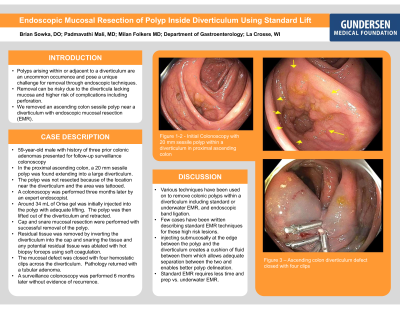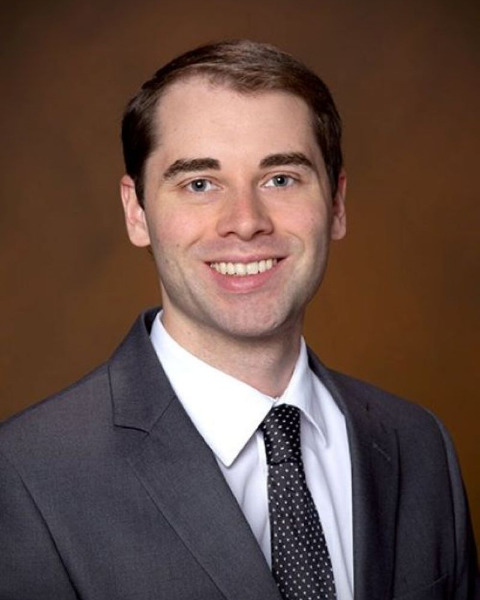Back


Poster Session A - Sunday Afternoon
Category: Colon
A0157 - Endoscopic Mucosal Resection of Polyp Inside Diverticulum Using Standard Lift Technique – A Case Report
Sunday, October 23, 2022
5:00 PM – 7:00 PM ET
Location: Crown Ballroom

Has Audio

Brian Sowka, DO
Gundersen Health System
La Crosse, WI
Presenting Author(s)
Brian Sowka, DO, Padmavathi Mali, MD
Gundersen Health System, La Crosse, WI
Introduction: Polyps arising within or adjacent to a diverticulum are an uncommon occurrence and pose a unique challenge for removal through endoscopic techniques. This type of removal can be less safe due to the diverticula lacking mucosa and higher risk of complications including perforation. We present a rare case of a patient presenting with an ascending colon sessile polyp near a diverticulum removed with endoscopic mucosal resection (EMR).
Case Description/Methods: 59-year-old male with history of three prior colonic adenomas presented for follow-up surveillance colonoscopy four years after the last. He was found to have multiple small and large-mouthed diverticula throughout the entire colon and in the proximal ascending colon a 20 mm sessile polyp was found extending into a large diverticulum. The polyp was not resected because of the location near the diverticulum and lack of expertise by the initial endoscopist and the area was therefore tattooed. A colonoscopy was performed three months later by an expert endoscopist after discussing the polyp removal techniques with the patient. Around 34 mL of Orise gel was initially injected into the polyp with adequate lifting. The polyp was then lifted out of the diverticulum and retracted. Later, cap and snare mucosal resection were performed with successful removal of the polyp. Residual tissue was removed by inverting the diverticulum into the cap and snaring the tissue and any potential residual tissue was ablated with hot biopsy forceps using soft coagulation. The mucosal defect was closed with four hemostatic clips across the diverticulum. Pathology returned with a tubular adenoma. A surveillance colonoscopy was performed 6 months later without evidence of recurrence.
Discussion: Various techniques have been used to remove colonic polyps within a diverticulum including standard or underwater EMR, and endoscopic band ligation. Few cases have been written describing standard EMR techniques for these high risk lesions. When injecting submucosally, it is helpful to inject into the edge between the polyp and the diverticulum to create a cushion of fluid between them which allows adequate separation between the two and enables better polyp delineation by pushing the polyp distally. It is vital to start the injection at the edge of the polyp and move the polyp away from the diverticulum. Standard EMR requires less time and preparation than underwater EMR and in the hands of a skilled advanced endoscopist is feasible for polyps located in diverticula.

Disclosures:
Brian Sowka, DO, Padmavathi Mali, MD. A0157 - Endoscopic Mucosal Resection of Polyp Inside Diverticulum Using Standard Lift Technique – A Case Report, ACG 2022 Annual Scientific Meeting Abstracts. Charlotte, NC: American College of Gastroenterology.
Gundersen Health System, La Crosse, WI
Introduction: Polyps arising within or adjacent to a diverticulum are an uncommon occurrence and pose a unique challenge for removal through endoscopic techniques. This type of removal can be less safe due to the diverticula lacking mucosa and higher risk of complications including perforation. We present a rare case of a patient presenting with an ascending colon sessile polyp near a diverticulum removed with endoscopic mucosal resection (EMR).
Case Description/Methods: 59-year-old male with history of three prior colonic adenomas presented for follow-up surveillance colonoscopy four years after the last. He was found to have multiple small and large-mouthed diverticula throughout the entire colon and in the proximal ascending colon a 20 mm sessile polyp was found extending into a large diverticulum. The polyp was not resected because of the location near the diverticulum and lack of expertise by the initial endoscopist and the area was therefore tattooed. A colonoscopy was performed three months later by an expert endoscopist after discussing the polyp removal techniques with the patient. Around 34 mL of Orise gel was initially injected into the polyp with adequate lifting. The polyp was then lifted out of the diverticulum and retracted. Later, cap and snare mucosal resection were performed with successful removal of the polyp. Residual tissue was removed by inverting the diverticulum into the cap and snaring the tissue and any potential residual tissue was ablated with hot biopsy forceps using soft coagulation. The mucosal defect was closed with four hemostatic clips across the diverticulum. Pathology returned with a tubular adenoma. A surveillance colonoscopy was performed 6 months later without evidence of recurrence.
Discussion: Various techniques have been used to remove colonic polyps within a diverticulum including standard or underwater EMR, and endoscopic band ligation. Few cases have been written describing standard EMR techniques for these high risk lesions. When injecting submucosally, it is helpful to inject into the edge between the polyp and the diverticulum to create a cushion of fluid between them which allows adequate separation between the two and enables better polyp delineation by pushing the polyp distally. It is vital to start the injection at the edge of the polyp and move the polyp away from the diverticulum. Standard EMR requires less time and preparation than underwater EMR and in the hands of a skilled advanced endoscopist is feasible for polyps located in diverticula.

Figure: A, B - Initial Colonoscopy with 20 mm sessile polyp within a diverticulum in proximal ascending colon
C - Ascending colon diverticulum defect closed with four clips
C - Ascending colon diverticulum defect closed with four clips
Disclosures:
Brian Sowka indicated no relevant financial relationships.
Padmavathi Mali indicated no relevant financial relationships.
Brian Sowka, DO, Padmavathi Mali, MD. A0157 - Endoscopic Mucosal Resection of Polyp Inside Diverticulum Using Standard Lift Technique – A Case Report, ACG 2022 Annual Scientific Meeting Abstracts. Charlotte, NC: American College of Gastroenterology.
